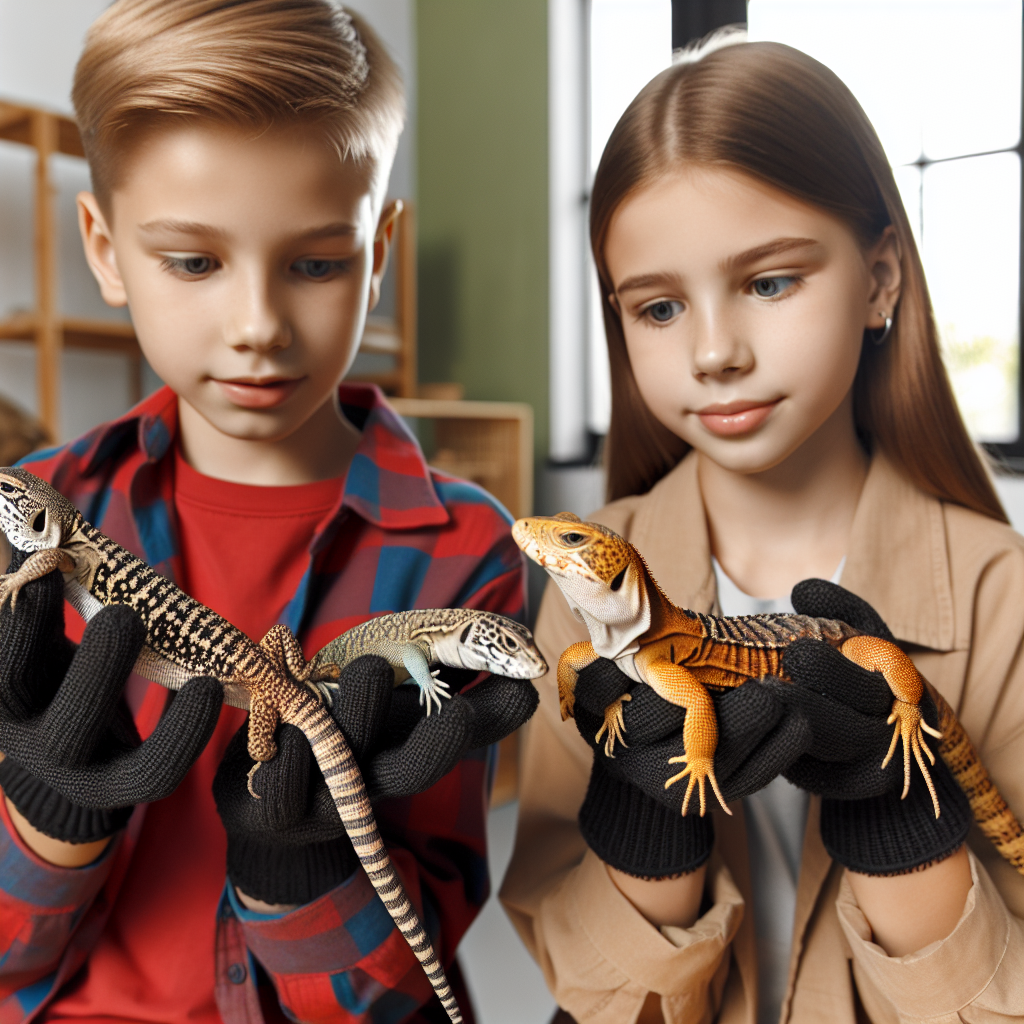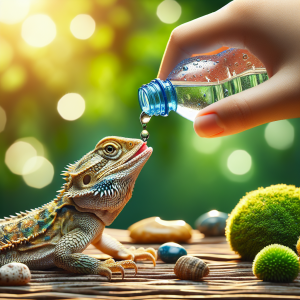Importance of Safe Lizard Handling for Children
Have you ever thought about the importance of teaching kids how to handle lizards safely? It’s not just about fun—it’s also about ensuring the well-being of both the children and the reptiles. I remember when my little cousin tried to pick up a lizard she found in the backyard, and let’s just say it didn’t end well for either of them! That’s why educating children on safe lizard handling practices is crucial.
Did you know that teaching children how to handle lizards properly can instill a sense of responsibility and respect for nature at a young age? It goes beyond just learning about reptiles; it’s about fostering empathy and care for living creatures. By guiding kids on the correct ways to interact with lizards, we are not only keeping them safe but also nurturing a sense of compassion and understanding for the environment around them.
One interesting fact about safe lizard handling for children is that different lizard species have specific needs and behaviors that should be considered when teaching kids how to handle them. For example, some lizards may be more delicate or easily stressed, requiring gentle handling and minimal disturbances. By educating children on these nuances, we can help them develop a deeper appreciation for the diversity of nature and the importance of treating animals with care and respect.
So, the next time you see a child excited to pick up a lizard, think about the impact of providing them with the knowledge and skills to do so safely. It’s not just about preventing accidents—it’s about fostering a lifelong love and respect for the amazing creatures that share our world.
Benefits of Teaching Children How to Handle Lizards Safely
Hey there! So, let me tell you about the benefits of teaching children how to handle lizards safely. Picture this: a group of kids excitedly gathered around a lizard, curious and eager to interact with it. It’s a wonderful sight, right? Well, teaching children how to handle lizards safely not only fosters their love for these fascinating creatures but also instills a sense of responsibility and empathy from a young age.
You know, I remember when my niece first held a lizard for the first time. She was a bit hesitant at first, unsure of how to approach it. But with gentle guidance and encouragement, she soon became more comfortable and confident in handling the lizard. It was a heartwarming moment to witness her curiosity and respect for the tiny reptile.
Now, here’s an interesting fact for you – did you know that teaching children how to handle lizards safely can enhance their motor skills and cognitive development? It’s true! The act of carefully holding and observing a lizard can improve a child’s hand-eye coordination and attention to detail. Plus, it teaches them to be patient and observant, essential skills that can benefit them in various aspects of their lives.
One practical tip that I find really helpful is to always supervise children when they are handling lizards. It’s crucial to teach them the correct way to hold and interact with the reptiles to prevent any accidents or harm to the lizards. By setting clear guidelines and boundaries, children can learn to handle lizards responsibly and develop a deeper understanding and appreciation for these creatures.
So, here’s a thought-provoking question for you – how can we create a safe and engaging environment for children to learn about lizard handling? By incorporating fun and educational activities, providing proper guidance, and emphasizing the importance of respect and care for lizards, we can ensure that children not only enjoy the experience but also develop a lifelong love for these captivating creatures.
Common Mistakes to Avoid When Handling Lizards with Children
You know, when it comes to handling lizards with children, there are definitely some common mistakes that are easy to make but important to avoid. One time, my friend’s son was so excited to hold their pet lizard for the first time that he tried to pick it up quickly without proper guidance. Needless to say, the lizard got startled and ended up scratching him a bit. It was a good lesson for all of us that taking the time to teach children the right way to handle lizards is crucial.
It’s fascinating to learn that many people don’t realize that lizards can easily become stressed when handled improperly. This is especially true for children who may not understand the importance of gentle handling and respecting the lizard’s boundaries. That’s why it’s essential to educate kids on the do’s and don’ts of interacting with these fascinating creatures.
Avoiding common mistakes when handling lizards with children can make the experience safer and more enjoyable for everyone involved. By teaching kids the proper techniques, such as approaching the lizard calmly and supporting its body correctly, you can help prevent accidents and ensure a positive interaction. Remember, patience is key when it comes to teaching children how to handle lizards responsibly.
Tips for Educating Children on Proper Lizard Handling Techniques
You know, teaching children how to handle lizards safely can be quite a fun and educational experience. One time, I was showing my niece how to gently hold a small gecko, and her face lit up with excitement when she realized she could interact with the reptile without scaring it. It was a heartwarming moment that made me appreciate the value of educating kids about responsible pet handling.
When it comes to educating children on proper lizard handling techniques, it’s essential to start with the basics. Kids are naturally curious, so I find that explaining things in a simple and engaging way works best. For example, you can demonstrate how to approach a lizard slowly and with gentle movements to avoid startling it. By incorporating fun activities like role-playing or storytelling, you can make the learning process both entertaining and informative.
One interesting fact about teaching children how to handle lizards is that it not only fosters a sense of responsibility but also helps them develop empathy towards animals. When kids learn to respect and care for living creatures, it instills valuable life lessons that can shape their character in a positive way. Plus, observing the unique behaviors of lizards can spark their curiosity and inspire a deeper appreciation for nature.
A practical tip I always emphasize is to supervise children closely when they interact with lizards, especially if they are young or inexperienced. It’s crucial to teach them the importance of being gentle and patient, as well as the significance of washing their hands after handling reptiles to prevent the spread of germs. By setting clear guidelines and boundaries, you can ensure a safe and enjoyable experience for both the kids and the lizards.
So, next time you’re teaching children how to handle lizards, remember to keep it fun, interactive, and educational. Who knows, you might just inspire the next generation of lizard enthusiasts!
Recommended Lizard Species for Children to Handle
Have you ever wondered which lizard species are ideal for children to handle? Well, let me share some insights with you on this topic.
When I was a kid, I remember being fascinated by lizards and wanting to hold them. However, not all lizard species are suitable for children to handle. Some lizards may be too fragile or have special care requirements that are not kid-friendly. That’s why it’s essential to choose the right lizard species for children to interact with.
Did you know that bearded dragons are often recommended as one of the best lizard species for children? Bearded dragons are known for their docile nature and relatively easy care requirements, making them an excellent choice for young reptile enthusiasts. Their gentle demeanor and manageable size make them less intimidating for kids to handle compared to other lizard species.
Choosing the right lizard species for children to handle is crucial in ensuring a positive and safe interaction. It’s essential to consider factors such as the lizard’s temperament, size, and care needs before introducing it to a child. By selecting a suitable lizard species, you can create a rewarding and educational experience for children while instilling a sense of responsibility and care for these fascinating creatures.
So, the next time you’re thinking about getting a lizard for your child or introducing them to these reptiles, remember to choose a species that aligns with their age, experience level, and interests. By selecting a lizard species that is well-suited for children, you can foster a love for nature and wildlife while promoting safe and enjoyable interactions between kids and lizards.
Creating a Safe Environment for Children to Interact with Lizards
Imagine setting up a mini reptile paradise right in your own home! When it comes to creating a safe environment for children to interact with lizards, there are a few key things to keep in mind.
First off, you’ll want to ensure that the enclosure for your child’s lizard friend is secure and escape-proof. Trust me, you don’t want a lizard on the loose in your living room! Make sure the lid is tightly secured and there are no gaps for Houdini-like escapes.
Next, consider the temperature and lighting within the lizard’s habitat. Different lizard species have specific temperature and lighting requirements to thrive. It’s like creating a cozy sunbathing spot for your scaly buddy!
Another important aspect is the substrate or bedding in the enclosure. This not only helps maintain cleanliness but also mimics the lizard’s natural habitat. It’s like giving your lizard a taste of the great outdoors indoors!
Additionally, providing hiding spots and climbing structures in the enclosure is crucial. Lizards love to explore and feel safe in their little hideaways. It’s like creating a lizard playground where they can roam, climb, and relax.
Don’t forget about water! Hydration is key for lizards, so make sure there is a clean water source available at all times. It’s like having a mini watering hole in their habitat.
Lastly, regular maintenance and cleaning of the enclosure are essential for the health and well-being of both the lizard and your child. It’s like giving the lizard’s home a spa day to keep it fresh and inviting.
By creating a safe and enriching environment for children to interact with lizards, you’re not only fostering a love for these fascinating creatures but also teaching important lessons in responsibility and care. So, gear up and get ready to watch your child’s eyes light up as they embark on this exciting lizard adventure!
Understanding the Behavior of Lizards and How to Communicate That to Children
When it comes to understanding the behavior of lizards and how to communicate that to children, it’s like unraveling a fascinating mystery! Have you ever noticed how lizards use body language to express themselves? It’s like they have their own secret code that we can decode.
Imagine this – you’re observing a lizard in its habitat, and you see it puffing up its throat. That’s like a lizard’s way of saying, “Hey, I’m feeling a bit threatened right now, so please give me some space.” It’s incredible how these reptiles have their way of communicating without words.
One interesting fact about lizard behavior is that they are masters of camouflage. Have you ever seen a lizard change its color to blend in with its surroundings? It’s like they’re playing the ultimate game of hide-and-seek! Teaching children about the camouflage skills of lizards can be both educational and entertaining.
When explaining lizard behavior to children, you can introduce the concept of tail autonomy – the ability of lizards to detach their tails when in danger. It’s like a lizard’s superhero power! Kids are often amazed by this unique adaptation and can learn about the importance of self-defense in the animal kingdom.
By understanding how lizards communicate and behave, children can develop a deeper appreciation for these fascinating creatures. Encouraging kids to observe and interpret lizard behavior not only fosters a sense of curiosity but also promotes empathy and respect for wildlife. So, next time you spot a lizard in action, take a moment to decode its movements and share the wonder of nature with the young ones around you.
Teaching Children the Importance of Respecting and Caring for Lizards
When it comes to teaching children the importance of respecting and caring for lizards, it’s all about instilling empathy and understanding early on. Remember that time we visited the reptile sanctuary and saw how excited the kids were to interact with the lizards? It was heartwarming to witness their curiosity, but it also reinforced the need to educate them on proper handling practices.
It’s fascinating how children can easily connect with animals, including lizards, but it’s crucial to teach them that these creatures have specific needs and boundaries. By explaining the importance of respecting the lizards’ space and handling them gently, we can help children develop a sense of responsibility and compassion towards all living beings.
One practical tip that resonated with me was creating a designated “lizard zone” where children can observe and interact with the reptiles under supervision. This not only ensures the safety of both the children and the lizards but also teaches them the significance of boundaries and respect in animal-human interactions.
Moreover, encouraging children to participate in caring for the lizards, such as feeding them or cleaning their habitat, can foster a sense of ownership and empathy. It’s amazing how these small gestures can cultivate a lifelong appreciation for nature and wildlife in children.
By engaging kids in hands-on activities that involve caring for lizards, we not only promote responsible pet ownership but also nurture a deeper connection with the natural world. After all, teaching children to respect and care for lizards is not just about the reptiles themselves—it’s about fostering empathy, compassion, and a sense of stewardship that will benefit them throughout their lives.
Fun and Educational Activities for Children to Learn About Lizards
Have you ever wondered how to make learning about lizards fun and engaging for children? Well, let me tell you, incorporating educational activities can be a game-changer! Picture this – setting up a mini lizard obstacle course in the backyard, complete with tunnels, branches to climb on, and even a small pool of water for them to navigate around. Not only does this get the kids moving and active, but it also teaches them about the natural behaviors of lizards in a hands-on way.
By introducing interactive activities like these, children not only learn about the physical abilities and preferences of different lizard species but also develop a deeper appreciation for these fascinating creatures. It’s amazing to see how kids light up with curiosity and excitement when they actively participate in creating a stimulating environment for their lizard friends.
Plus, did you know that engaging children in educational activities centered around lizards can also help them develop important skills such as observation, problem-solving, and empathy? Watching how they interact with the lizards and make connections between their actions and the lizards’ responses is truly heartwarming. It fosters a sense of responsibility and care that extends beyond just handling lizards – it teaches them valuable life lessons about respecting and caring for all living beings.
So, the next time you want to teach children about lizard handling, consider incorporating fun and educational activities into the mix. Not only will it enrich their learning experience, but it will also create lasting memories and a genuine passion for these remarkable creatures. And who knows, maybe you’ll discover a budding herpetologist in your midst!
Promoting Responsible Lizard Handling Practices for Children
Have you ever thought about the significance of teaching children the importance of respecting and caring for lizards? It’s not just about handling them safely but also fostering a sense of empathy and responsibility in kids.
Imagine this – a group of kids excitedly gathered around a pet lizard, eager to interact with it. As they learn about the lizard’s habitat, behavior, and needs, they start to develop a deep connection with the reptile. This experience not only educates them about lizards but also instills values like compassion and stewardship towards all living beings.
Now, let’s delve deeper into why promoting responsible lizard handling practices is crucial for children’s development. By teaching kids to respect and care for lizards, we are nurturing their empathy and understanding of the natural world. This not only benefits the lizards but also helps children become more compassionate individuals who value all creatures, no matter how small or scaly they may be.
As a parent or educator, you can guide children in creating a safe environment for lizard interactions, teaching them the proper techniques for handling these fascinating creatures. By incorporating fun and educational activities into their learning, you can make the experience both enjoyable and enriching.
So, the next time you see a child marveling at a lizard, take the opportunity to impart valuable lessons about responsible handling and care. Who knows, you might just be nurturing the next generation of wildlife enthusiasts and conservationists, all starting with a tiny lizard and a child’s curiosity.




